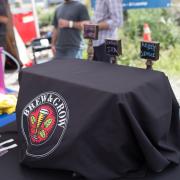Hey guys,
I've read the previous thread on the yeast bank planning, and I've talked about taking the lead on implementing a bank with plates. I've already been working on a plan. I've already started tackling this a little bit. I will start a google spreadsheet and post it in this thread, or in this forum if anybody has the capability of doing cell counts and would like to pitch in on collecting some data. If so, we'll meet and discuss to standardize methods and materials, which I believe to be important for a somewhat scientific approach.
The procedure below is complete for those who want to do everything themselves at home. I have prepared many plates and have a few strains growing on plates at the house. Most people will start at step 5.
Purpose
The goal of this study is to determine the optimal time, equipment, and environmental conditions to grow a yeast pitch with various strains and to create a reference for the CHAOS homebrewing club for this topic.
Materials
-
Required
-
500mL borosilicate Erlenmeyer flask
-
2000mL borosilicate Erlenmeyer flask
-
5000mL borosilicate Erlenmeyer flask
-
Pressure cooker
-
Aluminum foil
-
Parafilm
-
Light DME
-
Nichrome inoculation loop
-
Butane/propane torch, or Bunsen burner
-
Sterile transfer pipettes (autoclavable or disposable)
-
-
Optional, or I can provide
-
Stir plate and bar
-
100x15 mm petri plates
-
Agar agar
-
Microscope
-
Hemocytometer
-
-
Documents provided online
-
Google Docs note sheet
-
Google Docs note submission form
-
Google Docs spreadsheet for results
-
Method
This is stepwise from yeast selection to final pitching volume.
-
Prepare solid media
-
Dissolve DME at a rate of 100g/1000mL (1.040 starter wort)
-
Heat and dissolve agar agar into above solution at a rate of 17g per 1000mL
-
Put in Erlenmeyer flask and cover with foil, place in pressure cooker filling water just below the level filled in the flask
-
Close and boil for 15 minutes, cool to equalize
-
-
Pour petri plates
-
While performing step 1d, ready 20-25 plates closed and face up
-
Pour media into each plate so it barely covers the bottom and cover
-
Wrap edge of lid with parafilm and place in the refrigerator
-
-
Collect yeast sample (from dreg or pack)
-
Flame opener and bottle lip
-
Decant beer, resuspend dreg
-
Dump onto plate
-
Parafilm and leave out to allow yeast to grow, label with the following info
-
“Capture Plate”
-
Beer Name or Yeast Identifier (eg. Rogue Dead Guy, or WY1056)
-
Today’s date
-
-
-
-
Flame your inoculation loop until it glows red, allow it to cool for a few seconds
-
Pick up some of the yeast from the plate in step 2 and streak it near the edge of a new plate
-
Flame the loop, rotate the plate 45 degrees, drag a streak through previous streak once or twice, and continue to streak without touching the previous for a few more iterations
-
Repeat C until the entire area of the plate has been used
-
Parafilm and leave the plate out for a few days to allow yeast to grow, label with following info
-
“Isolation Plate”
-
Beer Name or Yeast Identifier (eg. Bell’s Hoplsam, or WLP004)
-
Today’s date
-
-
-
Prepare liquid media
-
Repeat the procedure for solid media, but leave out step 1b (agar agar)
-
-
Select single colony and streak a lawn on a new plate and leave out. Save all 3 plates produced by this process. This yeast is now banked.
-
Flame loop, pick up as much yeast as possible, and inoculate 200mL flask, replace foil and place on stir plate with sanitized stir bar
-
Grow for X days, record that number, record ambient temperature each day
-
Take sample with a sanitized or sterile pipette, dilute and count using hemocytometer, record cells/mL
-
I will write a separate document on this topic as the procedure is fairly complex for those who are not familiar.
-
Also note if you see bacteria, but no need to count. Should be obvious in tasting the supernatant of the next step up.
-
-
Pitch entire slurry into 2000mL of liquid media
-
repeat steps 6 & 7 above
-
Chill, decant and taste, resuspend, and pitch into either 2000mL or 5000mL of liquid media
-
Ideally you should take notes on flocculation, aroma, and flavors
-
-
repeat steps 6 & 7 above
-
Chill, decant and taste, and pitch into 5 gallons of beer and treat like it’s a normal brew
-
Note flocculation, aroma, and flavors again
-
-
Share the final product!
Optional Steps for the Ambitious
-
Oxygenate each step-up starter before pitching
-
Record which steps were oxygenated and for how long at what flow rate
-
Please record all of your results by filling out the Google Doc note sheet as completely as possible and submit using the Google Form. This will enter it into a spreadsheet for easy data management.
I don’t want this to be exclusive. I would like as many members to participate as are willing. This will lead to some limitations
Expected Limitations
-
Lack of standardized equipment and techniques leading to varying numbers
- Low number of data points











Looks like a great start, Mark!
As mentioned earlier, I can help with counts and such for the time being. I am looking to change positions soon, so I don't know how much longer I'll have access to my 'scope and hemocytometer.
I also have access to an autoclave for the time being as well.
Regardless, would love to help with this project, and I'll do my best to get as much done while I am in the position to do so.
Thanks for taking the lead on this and outlining everything here Mark!
Do you think that it is going to operate like our brew house where each person has there own plates & flasks and the yeast, scope, loop, flame, etc. are CHAOS owned?
Present
Everyone should provide their own basic equipment (pressure cooker, flasks, stir plate, loop, butane/propane gas torch, and liquid media). I can provide prepared solid media plates.
Regarding big ticket items, the purpose for the intense data collection here is so that nobody needs a scope or a hemocytometer in order to be confident that we are pitching the right amount of yeast per our conditions. If we can get enough data we won't need to do cell counts, so scope and hemocytometer will be unnecessary.
Plate storage of banked yeast I haven't found a space for yet. Prepared empty plates fit well on the top shelf of the fridge next to the kegerator (48 stack nicely in the side, the maximum amount of sterile plates I plan to keep around at one time). I might be able to donate a small cube fridge that could sit on top of another to be out of the way. There's also a space behind the bar next to the utensils where the chafing fuel is now.
Future
Several options have been raised for the provision of consumables (plates, agar, fuel, etc), most notably by donation basis by those who will use it. These costs are low and individually managable.
Larger purchases that might be nice to have for the club, but are not necessary considering the present model discussed above (pressure cooker, more stir plates, scope, hemocytometer) can be discussed at a meeting with the board.
Issues
Ideally and eventually, I would like to be able to leave several stir plates and flasks out for pitches that are growing up. This will require a lot of space and possibly a shelving unit. I don't know where we would put it, so it will require some discussion with the board and membership. I'm apprehensive that these will get contaminated with the fruit flies that are greatly reduced, but still present in low numbers.
Thanks for your support, Ken. Please let me know if you can think of anything that would be helpful to add to this plan!
The fruit fly problem (and other general dirtiness of the brewhouse) is my top concern with having live yeast samples around as well.
I'd personally like to see the plates stored in a refrigerator with no leftover food or beer as well.
As we talked about, we need to set up rules and guidelines for members to participate (or not) in this. More importantly, what goals do we have: maximum varieties of yeast? Additional income for the club? Is this an official chaos program or a project for a few interested people? There's still a lot up in the air and many ways we could go with this.
When this is better defined, we can go to the board for permission and any funds needed.
For those reading and not commenting, I'm expanding the plan into phases. For Matt, I sent a text.
I like what's going on here, and I'm interested in helping somehow, probably just with donations as I have no lab skills and little time to do much these days. I'm curious about the long term plans, I think we could potentially save members a lot of money if we are able to have a robust yeast growing operation.
I like what's going on here, and I'm interested in helping somehow, probably just with donations as I have no lab skills and little time to do much these days. I'm curious about the long term plans, I think we could potentially save members a lot of money if we are able to have a robust yeast growing operation.
Let me know next time you brew. I'll bank your lager strain.